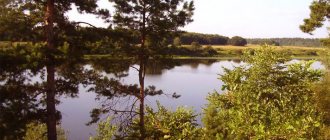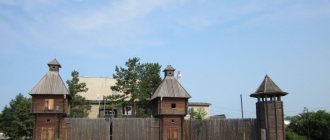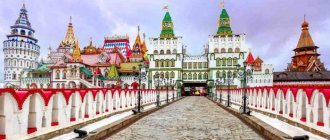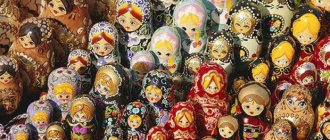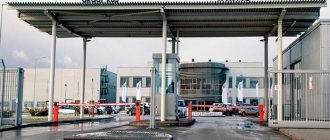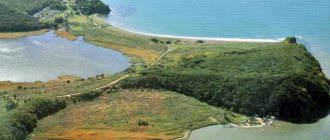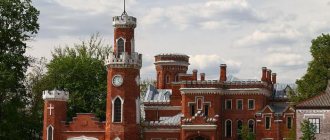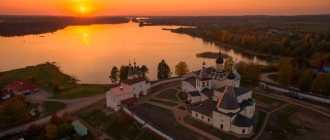The first inhabitants of the Nizhny Novgorod region appeared in the Mesolithic era; evidence of this is kept in museums.
It’s worth visiting this region to see the figure-eight staircase in Nizhny Novgorod, visit the places where Seraphim of Sarov lived and try to see the Russian Atlantis - Kitezh-grad.
Here you can learn how to make nesting dolls and weave lace, carve a figure out of stone and go fishing on Lake Vadsko.
In Nizhny Novgorod there is a piece of Switzerland - this is the name of the park with well-groomed paths, a zoo and fountains.
For ease of route planning, we have marked all mentioned cities and attractions on the map of the region:
Cities and villages
Nizhny Novgorod
The city was founded in 1211 and was intended for defense. After some time, the largest fair in Rus' was formed here. The city maintained independence from the capital and invaders and developed rapidly.
Now, thanks to a large number of monuments, Nizhny Novgorod is included in the list of the best cities in the world according to UNESCO.
Actor Evgeny Evstigneev, inventor Ivan Kulibin, author of the “dead loop” pilot Pyotr Nesterov, militia leader Kuzma Minin, writer Maxim Gorky, test pilot Valery Chkalov, children’s writer Arkady Gaidar and many others were born here.
- Nizhny Novgorod Kremlin. Construction of the fortress began in the 16th century to defend against Mongol-Tatar raids. Previously, there were 13 towers on the wall, now only 12 remain. According to legend, the library of Ivan the Terrible is hidden under the building. Nowadays there are excursions in the Kremlin; in the warm season you can walk along the wall.
- Michael the Archangel Cathedral. Although the temple is considered the oldest in the city, this rather refers to the place where it is located. The original building was destroyed several times, and in 1662 a stone cathedral was built. Previously, princes were buried here; their graves are still located on the territory. At the beginning of the 20th century, the ashes of Kuzma Minin were transferred. During the week after Easter, everyone is allowed to visit the bell tower and ring the bell.
- Nizhny Novgorod State Art Museum. It was founded in 1896. Among the exhibits are paintings and sculptures by Anton Bogolyubov, Mikhail Botkin, Konstantin, Nicholas Roerich, Ivan Repin.
- Pechersky Monastery. The temple was founded in 1328. In this monastery, Archimandrite Theodosius persuaded Dmitry Pozharsky to begin gathering troops to confront the Tatars. The main shrine of this place is the icon of the Mother of God of Pechersk.
More interesting things about Nizhny Novgorod and its attractions.
Gorodets
The city was founded in 1172 and was destroyed several times by the Mongol yoke. A special type of painting called Gorodets was invented here. Gorodets became the place of death of Alexander Nevsky. Today it is the most ancient settlement in the Novgorod region. He became famous for his crafts (carving, gold thread embroidery and baking).
- Museum of Local Lore. The collection contains historical documents, some dating back to the 14th - 16th centuries, folk crafts, and handicrafts.
- Samovar Museum. Located in a 19th century house that previously belonged to the merchant Grishaev. More than 500 items for tea drinking are collected here.
- Feodorovsky Monastery. According to legend, Prince Yuri Dolgoruky ordered it to be founded back in 1223, but the Tatars burned it down. After the restoration, Alexander Nevsky took monastic vows here.
- City of masters. The complex demonstrates changes in local architecture from the 16th to the 19th centuries. There is a museum here with samples of gold embroidery, pottery and Gorodets painting. Handicraft workshops are also held on site.
A detailed guide to the most interesting places in Gorodets.
Diveevo
The village was founded in 1559; the route to the Sarov monastery passed through it. It was founded by Seraphim of Sarov, a holy healer. In 1767, construction of the Church of the Kazan Mother of God began in the village. It is believed to be one of the four appanages visited by Our Lady.
In 1927, Diveevo was closed as a monastery complex, and the nuns were forced to leave. The place opened to the public only in 1981. In 2003, all churches began to be actively restored in honor of the centenary of the glorification of St. Seraphim of Sarov.
- Holy Trinity Cathedral Diveevo. It is the main cathedral of the monastery community. The relics of Seraphim of Sarov and other elders from the desert are kept here. According to legend, the Mother of God showed this place to Elder Seraphim in a vision. Initially, the temple was built as a summer temple to welcome everyone during the warm season. The inside of the cathedral is decorated with painted canvases; there is nothing like this in any Russian church. One of the shrines of this place is the icon of the Mother of God “Tenderness”, in front of which Seraphim prayed all his life.
- Holy Canal. Religious documents say that in 1825, Elder Seraphim saw the Mother of God indicating the construction of the Mill Community and surrounding it with a special ditch. The sisters of the future community dug along the path along which the Mother of God walked. The saint said that the groove would protect from the Antichrist in difficult times. It is believed that if you walk along it and pray to the Mother of God 150 times, she will definitely hear you.
- Source of St. Seraphim of Sarov. The holy place is located near the Satis River. Several dozen cases of miraculous healing at this source have been recorded. According to legend, in 1960, soldiers saw an old man in white. When the servants tried to speak to him, he struck the ground three times with his staff and disappeared. After some time, three keys appeared here. They tried to fall asleep several times, but the equipment kept breaking down, and this idea was abandoned.
- Iversky spring. It was dug by the Monk Alexandra in 1774 so that the workers could drink clean water. Workers quarried stones near this place for the construction of the Kazan Church. The stream got its name from the Iveron Icon, which was transported to the built church.
Interesting and useful facts about Diveevo temples.
Arzamas
The history of the city begins in 1552, when Ivan the Terrible ordered the construction of a fortress during his third attempt to conquer Kazan.
The writer Arkady Gaidar, the exiled Maxim Gorky, and academician Alexey Stupinin, who organized a painting school, lived here. While passing through the city, the writer Leo Tolstoy and Empress Catherine the Great visited.
- Cathedral of the Resurrection of Christ. It was founded in honor of the victory over Napoleon in 1812. In all its time it has never been subjected to destruction or reconstruction. The miraculous icon of Nicholas of Mozhaisk and the Life-giving Cross of the Lord are kept here, as well as the icon of the Resurrection of Christ, painted in the 16th century.
- City History and Art Museum. In 1956, a local history museum was placed in the building of the Elias Church (now an architectural monument). Later, the exhibition dedicated to nature was removed, and the donated collection of paintings helped the museum gain the status of an art museum. Here are the decorations, weapons and tools of the Mordovian tribes who lived in these areas in the 1st millennium AD. Some of the exhibitions tell about the history of the city's development; there are collections of porcelain and religious objects.
- Literary and Memorial Museum of Arkady Gaidar. Located in the house where the writer’s family used to live. In addition to household items and personal belongings of the writer, the original manuscripts of Pavel Bazhov and Maxim Gorky are kept here.
- Church in honor of the icon of the Most Holy Theotokos “Life-Giving Spring”. The temple was built in 1794. The main shrines are the icons “Cathedral of the Blessed Virgin Mary” and “Life-Giving Spring”. In warm weather, you are allowed to climb the bell tower, from where you can see the entire city.
Everything a tourist needs to know about Arzamas.
Dzerzhinsk
The city was founded in 1606 and was originally the village of Rastyapino. It began to grow after the construction of the railway in 1862. In the 30s of the 20th century, when a plant for processing mineral acids was founded, Dzerzhinsk acquired the status of a city. Now it is the largest industrial center in the Novosibirsk region.
- Museum of Local Lore. 9 exhibition halls tell about the history of the city, the events of the Great Patriotic War, there are departments dedicated to the nature of the region and the life of local residents in the 17-19 centuries.
- Church ensemble on Svyato-Tikhonovsky Proezd. The complex is still being completed, but the wooden Resurrection Parish and the Church of John the Baptist have already been consecrated.
- House with a spire. It was built in 1955 according to the design of Alexander Kusakin. Currently under reconstruction.
Bogorodsk
The city was founded by 300 residents of the Nizhny Novgorod freemen, who, by order of Ivan the Terrible, were evicted from their places of residence. The name of the settlement is derived from the Church of the Blessed Virgin Mary.
- Historical Museum. The collection contains examples of pottery and leather production from the founding of Bogorodsk, old photographs and documents about the history of the city.
- Chapel of St. Equal-to-the-Apostles Prince Vladimir. There is a spring nearby that is considered healing.
- Red Square. The first one built in the city, next to it are the houses of the merchants Golovastikovs, Obzhorins and Losevs.
Sarov
Nuclear physicists have settled in the Russian science city since 1946. The best Soviet scientists worked in the city: Igor Kurchatov, Andrei Sakharov, Alexey Bessarabenko. Sarov's secrecy was lifted after the collapse of the USSR, but the city still remains closed. You can get here only by invitation of relatives living in the city or local employers.
Sarov has a rather unusual atmosphere: here, without contradicting each other, science and faith are combined. And city scientists even consider Seraphim of Sarov their patron.
Religion appeared in the village much earlier than science. In the 17th century, a monastery was erected near the Sarov Desert, around which residential buildings were gradually built. Almost until the middle of the 20th century, the city remained the religious center of the country - pilgrims came from all over Russia to venerate the relics of Seraphim of Sarov.
The first design bureau was built after the war right on the site of the destroyed monastery. Sarov was so classified that it was not even on the maps of the country. Since the 1990s, churches in the city began to be restored, and in 2006 the Church of Seraphim of Sarov opened.
Sights of Sarov:
- Museum of Nuclear Weapons with a model of a nuclear bomb;
- Monastery Square, where most of the city’s churches are located;
- Museum of History and Local Lore with 40 permanent exhibitions;
- Natural monuments: monastery ponds; silver keys; The distant desert where Seraphim of Sarov lived;
- Administrative building of the nuclear center 1911
What else is interesting in Sarov, why would it be worth trying to get here?
Urbanization level
A very important demographic indicator is the level of urbanization. It will help to understand how the population of the Nizhny Novgorod region is distributed between cities and villages.
The number of inhabitants of the cities of this Volga region today is about 2590.8 thousand inhabitants. At the same time, 669.5 thousand people live in villages. The population of the cities of the Nizhny Novgorod region is almost four times higher than the rural population.
Thus, the percentage of population between urban and rural areas is 79.5 and 20.5%, respectively. This suggests that the Nizhny Novgorod region is a fairly urbanized region. Of course, in comparison with the Murmansk region or the Khanty-Mansi Autonomous Okrug, where the share of urban residents exceeds 90%, the indicator of the Volga region will not seem so high, but in comparison with the Republic of Ingushetia (41.3%), the Republic of Chechnya (34.8 %) and even more so with the Altai Republic (29.2%) it looks quite convincing.
Natural attractions
Bornukovskaya Cave
Coordinates: 55.389825, 44.780878 Address: s. Bornukovo How to get there: from Nizhny Novgorod along the M-7 highway to the village. Malinovka, further along the highway 22K-M64 to the village. Bornukovo, 2 hours 40 minutes, 150 km, by bus 3 hours 12 minutes.
The caves were formed after the development of quarries for the extraction of alabaster. The total length of all grottoes is 200 meters.
They gained their popularity due to the layer of ice that covers all the caves from the inside all year round.
Visiting caves without an accompanying person and special equipment is dangerous.
Vad lake
Coordinates: 55.539784, 44.191932 How to get there: from Nizhny Novgorod along the P-158 highway to the village. Vad 1 hour 43 minutes, 110 km, by bus 2 hours 17 minutes.
The peculiarity of the reservoir is a stream of cold water gushing from underground. It emerges from an underwater karst cave. The lake does not freeze in winter due to the current.
Previously, there was a diving club here, whose employees helped everyone explore the cave at the bottom, but in 2007 the entrance collapsed. You can dive to the bottom now, but you won’t be able to get into the cave.
You can go fishing on the lake; silver carp, pike and roach are well caught.
Ichalkovsky pine forest
Coordinates: 55.437297, 44.537652 How to get there: from Nizhny Novgorod along the P-158 highway to the village. Kriusha, then turn left and reach the village. Ichalki, 2 hours 8 minutes, 130 km, by bus 2 hours 47 minutes.
The territory of the forest is part of the reserve. There are more than 1000 karst caves of various shapes and depths in the forest. The deepest are the Kuleva and Startsev pits, 25 and 19 meters.
There are legends that local robbers hid treasures in the Kuleva Pit. According to another version, suicides chose this place to die. Researchers found no evidence to support both beliefs.
The forest also contains plants from the Red Book - steppe cherry and relict ferns; rare animals include imperial eagles and ground hares.
Lake Svetloyar, Nizhny Novgorod region
Coordinates: 56°49′07″ 45°05′35″ Address: s. Vladimirskoe How to get there: from Nizhny Novgorod along highway 22R-054 to the village. Vladimirskoye 1 hour 50 minutes, 130 km
The reservoir received its name from the name of the sun god Yarila, who was worshiped by pagans on its banks. Every year on July 6, a religious procession is held here in honor of the Vladimir Icon of the Mother of God, and in the evening Ivan Kupala is celebrated. They say that if you walk around the lake three times that night and make a wish, it will come true.
Old Believers believe that at the bottom of Svetloyar lies the city of Kitezh, saved by God from Batu Khan. According to legend, on moonlit nights you can hear the ringing of bells and the crying of people from the underwater city.
Lake Charskoye
Coordinates:
Address: pos. Mukhtolovo
How to get there: from Nizhny Novgorod along the highway 32K-0125 to the village. Mukhtolovo, 2 hours 17 minutes, 140 km
A feature of the reservoir is periodic shallowing, the reasons for which have not been clarified. During the period of deep water, pike, carp, perch and lenok are caught here.
Kerzhensky Reserve
Address: pos. Rustai Phone: +7 831 431‑30-56, +7 831 431‑31-91 Website: kerzhenskiy.ru Cost: 50 rubles How to get there: from Nizhny Novgorod along the highway 22K-0125 to Rustai village, 1 hour 52 min ., 78 km
The protected area contains forests and swamps.
Lynxes, bears, hares, bats, eagles and hawks live here. The flora is represented by coniferous and deciduous trees, shrubs and berries - cranberries, blueberries and wild raspberries.
Visits to eco-trails are organized for tourists at any time of the year.
Beautiful Nizhny Novgorod lakes: TOP-8
Another type of water resource in the Nizhny Novgorod region is lakes. Of course, there are not as many such natural objects as rivers, but among them there are examples of interest to tourists and travelers.
Lake Bolshoy Kultey
- Coordinates: 411565, 45.738944.
This reservoir is a natural monument under state protection. Several species of very rare sphagnum mosses grow in its vicinity.
The water pool is located in a funnel-shaped basin and has high, sometimes steep, banks. The lake is surrounded by mixed forest, although the water surface is mostly open. The bottom is covered with a large layer of silt. The average depth is about 3 m. The view of the island is especially beautiful. Bolshoi Kultey from its eastern shore - there is also an excellent place for a tourist stop.
Nearby is the “Kulteysky Spring”, consecrated for the two thousandth anniversary of Christianity. The most convenient sandy access to the waters of the lake is located near the spring.
Lake Svetloyar
- Coordinates: 818784, 45.093056.
A huge number of legends and traditions are associated with this reservoir. The waters of Svetloyar are considered holy, giving healing to all who suffer. They say that it was in these places that the Virgin Mary herself left her mark.
Indeed, many events are associated with the lake that cannot be scientifically explained. Legend claims that it was its waters that swallowed up the ancient city of Kitezh, famous for its wealth.
The flow of pilgrims and people who believe in miracles to the lake does not decrease. It is interesting that every year some events take place here that further strengthen faith in the Mother of God, who took these places under her protection.
Lake Bolshoye Plotovo
- Coordinates: 459144, 45.603308.
It is located almost in the center of the Raft Swamp. You can go through the latter when you reach the shoreline of the reservoir. The area got its name due to the fact that local residents here moved not on traditional boats, but on rafts.
The Big Plotskoye Lake itself has quite impressive dimensions - length is 2.2 km, and width is about 1.6 km. Three kilometers from it there is about. Maloe Plotovo. The closest and most convenient approaches to Bolshaya Plotovo are from the south.
Lake Maloye Plotovo
- Coordinates: 422077, 45.568884.
As befits a “younger” brother, this reservoir is smaller in size. It covers an area of about 50 hectares. Researchers believe that in some places the depth of the water basin reaches 18 m. The lake is also surrounded by swamps and there is no free access to it.
The reservoir has had a bad reputation since ancient times. There is a legend about a certain island that appears and disappears in the center of the lake. It draws in people who find themselves on this piece of land. It is believed that this is the abode of swamp evil spirits.
Since 1976, Maloe Plotovo has become a natural monument, and its few guests are fishermen who come here to catch tench and pike.
Lake Bolshoye Polyushkino
- Coordinates: 249827, 45.446237.
This reservoir is also located among swamps. Not far from it there are two more lakes - Malye Yazy and Maloe Polyushkino.
The largest of the water basins is not very impressive in size - only 700 by 400 m. Bolshoye Polyushkino has the shape of an irregular oval, surrounded by marshy banks.
Those who like to fish in this reservoir have their own forum. According to the information provided by the portal, you can find out that the average depth of Bolshoy Polyushkino is 3-4 m. Perch bites especially well here, and black grouse are found in the surrounding forests.
Lake Svetloe
- Coordinates: 535646, 45.477041.
A fairly large body of water, about 1 km in diameter. The water in it is clean, but the bottom is muddy. There are practically no deep-water areas here - only from 1 to 3 m. The shores are surrounded by moss rafts. In these places you can harvest a good crop of cranberries.
The southern side of the lake is most convenient for excursions. There is a place where you can camp, there are approaches to the water and places for swimming.
In the northern part there are several islands formed by rafting. In these small areas of land, mainly pine and birch grow. Near the southern border is the Udel swamp, where one of the tributaries of the Linda, the Visets River, originates.
Black Lake
- Coordinates: 592144, 45.576772.
A large and beautiful reservoir surrounded by swamps. Perhaps because of this, the impression of some kind of gloom is created, which is reflected in the name of this landmark of the Nizhny Novgorod region.
The shape of the lake is a clearly visible figure eight, where the northern part is larger than the southern mirror. The eastern shore has convenient access to the water and parking space. The opposite bank is adjacent to the Kerzhensky Nature Reserve.
On the swampy shores of the Black Lake you can find rafts where cranberries grow. Once upon a time, logging work was carried out in these places. To organize the removal of the tree, a narrow-gauge railway was built from the south.
Lake Ryzhan
- Coordinates: 342231, 45.819685.
An interesting and quite large body of water. The shape of the lake is unusual - it is an irregular rhombus, reminiscent of the tip of a spear. The water basin stretches from north to south, and there are many good approaches to it.
The lake at its widest part reaches almost 900 m, and the distance from the southern point to the northern is about 2.8 km.
The beauty of the local landscapes is added by the pine and birch forests surrounding the lake. The southern shores of the water basin are high - there is a road going around the reservoir. In the northern part the coast is a little swampy.
The northeastern coast of the reservoir has convenient tourist parking and access to the water. On the west coast, in the central part, there is the only sandy beach suitable for swimming.
Historical sites and museums
Museum and tourist center in Semenov
Address: Semenov, st. Chkalova, 15B Phone: +7 920 252‑72-00, +7 83162 5‑61-41 Website: semenov-museum.ru Opening hours: Mon-Fri 9:00-18:00; Sat 9:00-13:00; Sun 10:00-16:00 Cost: 100-450 rubles
The museum is built in the form of a painted tower. Here are collections of objects painted with Khokhloma - dishes, toys and even furniture.
In the “Royal Room” the walls and a three-meter throne are decorated, and there is a set of carved figures - 240 objects in total.
The complex's employees conduct master classes on making and painting toys.
Vetluzhsky Museum of Local Lore
Address: Vetluga, st. Lenina, 1A Phone: +7 83150 2‑25-60 Website: vmuzeum.nnov.muzkult.ru Opening hours: Mon-Fri 8:00-17:00; Sun 8:00-14:00 Cost: 14-35 rubles
The museum occupies an old merchant's house from the 19th century.
On the ground floor, the natural world of the Vetluzh region is presented - stuffed animals and herbariums. The second floor is dedicated to the history of the region and the city. There are household and art objects from estates and peasant houses, a collection of weapons and cannons from the times of Peter the Great.
You can also see a collection of handwritten and early printed books.
The next room is dedicated to the history of persecution of Orthodox Christians in Soviet times.
Mining Museum in Peshelani
Address: s. Peshelan Phone: +7 83147 5‑52-81 Website: pgz-tour.ru/obekty/1 Opening hours: Mon-Sun 8:00-17:00 Cost: 400 rubles How to get there: from Nizhny Novgorod along the P-158 highway to s. Peshelan 2 hours 5 minutes, 130 km, by bus 1 hour 32 minutes.
The museum is located in a mined mine at a depth of 65 meters. The exhibition includes old stone carts and rock mining tools. In addition, the site of an ancient man was reconstructed here and a psychological camp was equipped.
You can spend time with health benefits in a shungite room - this rock is believed to have healing properties.
At the very bottom there is a so-called panic room with various frightening mannequins.
Lace Museum in Balakhna
Address: Balakhna, st. Karla Marksa, 4 Phone: +7 83144 6‑16-62, +7 83144 6‑28-40 Website: bmihk.ru Opening hours: Mon, Tue, Wed, Thu, Fri, Sun 9:00-17:00 Cost : 100-340 rubles
The main exhibits of the museum are samples of lace from the 19th century.
There are creations for everyday needs: clothes, scarves, bed linen and towels. The collection also contains lace icons from the 17th century and works from the Soviet period.
A design invented by local craftsmen—the “robe rose”—adorned the wedding dress of Queen Victoria of England.
Voznesensky Matryoshka Museum
Address: Voznesenskoye town, st. Sovetskaya, 14 Phone: +7 83178 6‑11-62, +7 83178 6‑11-16 Website: voznmuseum.rfnn.ru Opening hours: Mon-Thu 8:00-17:00; Fri 8:00-16:00; Sat 9:00-13:00 Cost: 30-60 rubles
A tour of the museum begins with the history of toy production; there is even a production model carved out of wood and a real tool from the 18th century.
There is also a prototype of the matryoshka doll - the Chinese toy Futurama. The figures are of different heights, some are almost two meters tall and some are tiny, the smallest is only 5 mm.
In addition, the museum has exhibitions on the following topics: “Russian hut of the 19th century”, “Voznesensky and Izhevsk factories of the Batashev brothers”, “Forties - fatal”, “Factory Polkh-Maidan painting”, “Archaeology”, “Clothing of the 19th-20th centuries "," Lapot-bast."
After the tour you can attend master classes.
Museum of Speed in Chkalovsk
Address: Chkalovsk, st. Chkalova, 4 Phone: 8-(83160)-4-20-51 Website: https://russian wings.rf/musey_skorostey Opening hours: Mon-Sun 9:00-17:00 Cost: 50-200 rubles
The first exhibition of the museum is dedicated to barge haulers, who were hired by shipbuilders here. The following describes the appearance of the first steam ships and ekranoplanes.
Most of the exhibition is dedicated to Rostislav Alekseev, the first person who managed to construct flying ships. In a separate room there are items from his office, first developments and awards.
The museum's collection also contains household items of merchants and peasants from the 18th to 20th centuries.
Semenovsky Historical and Art Museum
Address: Semenov, st. Vaneeva, 5 Phone: +7 83162 5‑19-30, +7 83162 5‑61-4 Website: semenov-museum.ru Opening hours: Mon-Fri 9:00-18:00; Sat 9:00-13:00; Sun 10:00-16:00 Cost: 25-50 rubles
Most of the collection was collected by Georgy Matvey, a woodcarver.
Part of the exhibition represents the life of the Old Believers; there is a model of their monastery. The collections also contain a collection of various spoons and nesting dolls. A separate room is dedicated to the works of writers Boris Kornilov and Sergei Afonin.
Pashkov Estate
Address: s. Vetoshkino How to get there: from Nizhny Novgorod along the M-7 highway to the village. Vetoshkino, 2 hours 47 minutes, 170 km
The estate was built over 40 years, from 1826 to 1866. Previously, there were many premises on the territory: a residential building, an outbuilding, outbuildings and a stud farm.
Now almost everything has been destroyed, but parts of the decoration can still be seen on the ruins of the house, and an exhibition of Gzhel art has been placed in the outbuilding.
Levashov estate in Galibikhe
Address: s. Galibikha How to get there: to Nizhny Novgorod along highway 22B-015 to Galibikha, 2 hours 23 minutes, 160 km, by bus 2 hours 49 minutes.
The estate is a complex of wooden buildings from the early 19th century.
Four houses are closed to the public due to their dilapidation, but the open house contains a small exhibition telling about the owners of the estate.
It is known that Alexander Pushkin visited here, and the complex itself was built according to the design of Andrei Delvig.
Museum-Reserve of A. S. Pushkin “Boldino”
Address: s. Bolshoye Boldino, st. Pushkinskaya, 144 Phone: +7 83138 2‑33-77, +7 83138 2‑29-52 Website: boldinomuzey.ru Opening hours: Tue-Sun 9:00-17:00 Cost: 250 rubles How to get there: from Nizhny Novgorod along the M-7 highway to the village. Bolshoye Boldino, 3 hours 22 minutes, 220 km, 4 hours by bus.
The estate in the village belonged to the Pushkin family for more than 300 years. Here the writer created the last chapters of “Onegin”, “The Miserly Knight”, “Mozart and Salieri”, “A Feast during the Plague”, “Don Juan”, “The Bronze Horseman”, “Angelo”, “The Tale of the Fisherman and the Fish”.
The furnishings inside the estate have been restored as they were during the poet’s lifetime, and all items are original.
The reserve also includes an estate in Lvovka, the Museum of Fairy Tales and the houses of the Uspensky and Fialkovsky priests.
Shukhov Tower on the Oka River
Address: Dzerzhinsk
The building, 128 meters high, is the only one of its kind in Russia. Has the title of cultural heritage of the Nizhny Novgorod region.
You cannot climb to the top of the tower, but the area nearby is landscaped with benches and flower beds.
If you look at it while standing next to it, it creates the illusion of tilting.
National composition
Now let's find out the national composition of the region's inhabitants. The population of the Nizhny Novgorod region is quite ethnically diverse. The nationalities that represent the region are quite diverse. But among them the Russians stand out numerically. Currently, their number in the Nizhny Novgorod region is approximately 3110 thousand people, or 93.9% of the population of the entire region. Thus, this nationality has unconditional dominance in this subject of the Federation. This situation has persisted for hundreds of years. It must be said that for the XX-XXI centuries. the percentage of Russians to all residents of the region never fell below 92%.
Among the national minorities inhabiting the Nizhny Novgorod region, Tatars are in first place. This is due to the proximity of the region to the Republic of Tatarstan. The number of Tatars is about 44 thousand people, or 1.33% of the total population. Tatars in terms of number of residents are followed by Mordovians (0.58%), Ukrainians (0.53%), Armenians (0.4%) and Chuvash (0.29%).
Among the population of the Nizhny Novgorod region there are also such exotic nationalities as Koreans and Yezidis, but their number is quite small and does not exceed several thousand people.
Parks, entertainment and more
Ostrich farm in Gremyachevo
Address: Gremyachevo village, st. Lugovaya, 2A Telephone: Opening hours: Mon-Fri 8:00-17:00, break 12:00-13:00; Sat, Sun 8:00-16:00 Cost: 50 - 70 rubles How to get there: from Nizhny Novgorod along the highway 32K-0125 to the village. Mukhtolovo, then after 8 km turn left and get to Gremyachevo, 2 hours 45 minutes, 160 km, by bus 4 hours 17 minutes.
The farm is home to African ostriches, Cameroonian goats, turkeys and chickens of various breeds.
The workers will talk about the history of the creation of the farm, the rules of caring for animals that can be fed.
You can also try an ostrich egg omelette and purchase crafts made from the feathers of these birds.
Population
First of all, you should find out the population of the Nizhny Novgorod region. After all, most other demographic data are calculated based on this indicator. So, the population of the Nizhny Novgorod region today is 3260.3 thousand people, which is the eleventh largest figure among 85 regions of Russia. In percentage terms, the number of residents of the Novgorod region is 2.22% of the population of the Russian Federation.
Next we will look at other indicators of the region's demographics.
Churches, cathedrals and temples
Iversky Convent in Vyksa
Address: Vyksa, st. Krasnoflotskaya, 58 Phone: +7 83177 3‑22-41, +7 920 299‑61-03 Website: vm1864.ru Opening hours: Mon-Sun 9:00-18:00
The site for the future monastery was chosen by the Monk Barnabas - at the request of local merchants. According to legend, he stuck a branch into the ground deep in the forest. Nuns and the holy fool Dmitry Pivovarov soon settled in the monastery.
In 1927, they decided to blow up the monastery; the nuns who refused to leave the monastery died. After the church building was returned, it was reconstructed - a bell tower and a Trinity chapel were erected. The main shrine of the temple is the miraculous Iveron Icon of the Mother of God. It was kept by a watchman after the explosion.
Despite ongoing renovations, services are still taking place here.
Makaryevsky Monastery
Address: s. Makaryevo Phone: +7 83149 5‑91-69, +7 83149 5‑93-60 Website: makaryzhelt.cerkov.ru Opening hours: Mon-Sun 6:00-19:00 How to get there: from Nizhny Novgorod along highway 22K- 021 to s. Makaryevo, 1 h. 46 min., 90 km, by bus 2 h. 34 min., also can be reached by ferry from N. Novgorod
The parish was founded in the 15th century. Under Soviet rule, the building was closed; now most of the buildings are under reconstruction.
Here you can venerate the relics of St. Macarius, the founder of the monastery.
There is also an ancient cemetery on site where monks are buried since the 15th century.
St. Nicholas Church of Balakhna
Address: Balakhna, Revolution Avenue, 17 Phone: +7 83144 6‑15-39 Website: podpokrovom.ru Opening hours: Mon-Sun 7:00-19:00
The second oldest building in the region after the Nizhny Novgorod Kremlin.
The relics of Saint Paphnutius, who founded the Intercession Monastery, are kept here. Until 1929, the iconostasis was decorated with the miraculous Hodegetria icon; after the church was closed, it disappeared.
Oransky Mother of God Monastery
Address: s. Oranki, st. Pochtovaya, 2 Phone: +7 929 044‑60-05 Website: orankimon.rf Opening hours: daily, around the clock How to get there: from Nizhny Novgorod along the M-7 highway to the village. Oranki, 1 hour 43 minutes, 82 km
According to legend, local merchant Pyotr Andreevich saw the Mother of God in a dream, who told him to found a temple. He soon abandoned worldly life and built a church in three months.
The miraculous Oran Icon is kept here, which was saved during the 1917 revolution.
There is also a holy spring with a font on the territory.
Population density
Density can be calculated by knowing the number of people in the Nizhny Novgorod region and the area of the territory occupied by them.
The area of the region is 76,624 square meters. km. Thus, by simple calculations it can be established that the average population density of the Nizhny Novgorod region is 42.6 people/sq. km. This is the 23rd result out of 85 regions of the country. If we do not take into account the population density in regions whose main territory is cities, then the Nizhny Novgorod region will be in 20th place. For comparison: in the most populated region of the country (Moscow), the population density is 164.9 people/sq. km, and in the most deserted region (Chukchi Autonomous Okrug) – 0.1 people/sq. km.
So the Nizhny Novgorod region looks good in the all-Russian statistics on population density. The area and population of this region are correlated in such a way that the number of people living here is higher than in a significant part of other subjects of the Federation.
Number of residents in individual districts of the Nizhny Novgorod region
Now let's determine the most populated areas of the Nizhny Novgorod region. Which municipalities in the region have the largest population?
The largest number of residents is in the Kstovsky district - 115.8 thousand. Next in population are Gorodetsky (89.2 thousand people), Balakhninsky (76.9 thousand people), Bogorodsky (66.3 thousand people) and Volodarsky (58.2 thousand people) districts.
It should be clarified that those cities that we talked about above, namely Nizhny Novgorod, Dzerzhinsk, Arzamas, Sarov and Bor, do not belong to administrative districts, but are separate urban municipalities.
